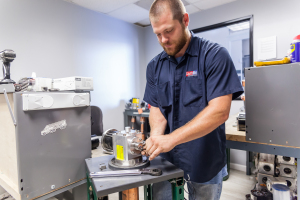by
John R. Fischer, Senior Reporter | September 19, 2022
From the September 2022 issue of HealthCare Business News magazine
The breakdown of an MR system’s coldhead can be a costly expense. One hospital learned this the hard way when it went one week without realizing that its own was not working. By the time the problem was found, 1,200 liters of liquid helium had been lost, and the scanner’s magnet level dropped to 10%.
The provider ended up spending tens of thousands on a new coldhead and 1,750 liters in replacement liquid helium, according to Sean Mykleby, president of Thermo Magnetics & Cryogen, an independent equipment sales business in Ontario, California that is partially owned and associated with SouthWest Medical Resources (SWMR), which services coldheads, as well as other cryogenic parts.
“A simple remote monitoring service could have prevented an emergency fill, loss of hundreds of liters of helium, and rushed overnight shipping charges. If they’d have had our Helium Zero service, it would have saved them almost $60,000,” he told HCB News.



Ad Statistics
Times Displayed: 137929
Times Visited: 7957 MIT labs, experts in Multi-Vendor component level repair of: MRI Coils, RF amplifiers, Gradient Amplifiers Contrast Media Injectors. System repairs, sub-assembly repairs, component level repairs, refurbish/calibrate. info@mitlabsusa.com/+1 (305) 470-8013
While often forgotten, components like coldheads, compressors and chillers are crucial for maintaining the proper magnet temperature to ensure scanners are at their peak performance. Breakdowns not only disrupt imaging and workflow but create delays that can pose risks to timely diagnosis for patients.
HCB News spoke with Mykleby, and Turner Hansel, president of Filtrine Manufacturing, which installs and maintains chillers, to discuss the vital roles these components play, and what precautions to take to prevent them from breaking down.
Knowing your MR components
In an MR system, the chiller keeps internal components such as shield coolers and shim coils cool by removing heat from the liquid helium. Options vary based on the specific temperatures they are designed to tolerate. For example, a chiller designed to keep MR scanners cool in 90-degree Fahrenheit maximum ambient conditions will not be able to handle the same heat load when the temperature reaches the triple digits.
This makes extreme heat in the summer a grave concern, as many of these components are located on the outside of MR imaging facilities and are at higher risk of breaking down in these conditions.
“That will cause the coolant supply temperature going to the MR to rise, which will affect the quality of the image and may cause the MR to go down due to high temperature. Or the chiller may fail due to high pressure. Every chiller installation for an MR must have the ability to provide backup cooling to prevent damaging the MR if the chiller fails,” said Hansel, of Filtrine, which is in Keene, New Hampshire.

